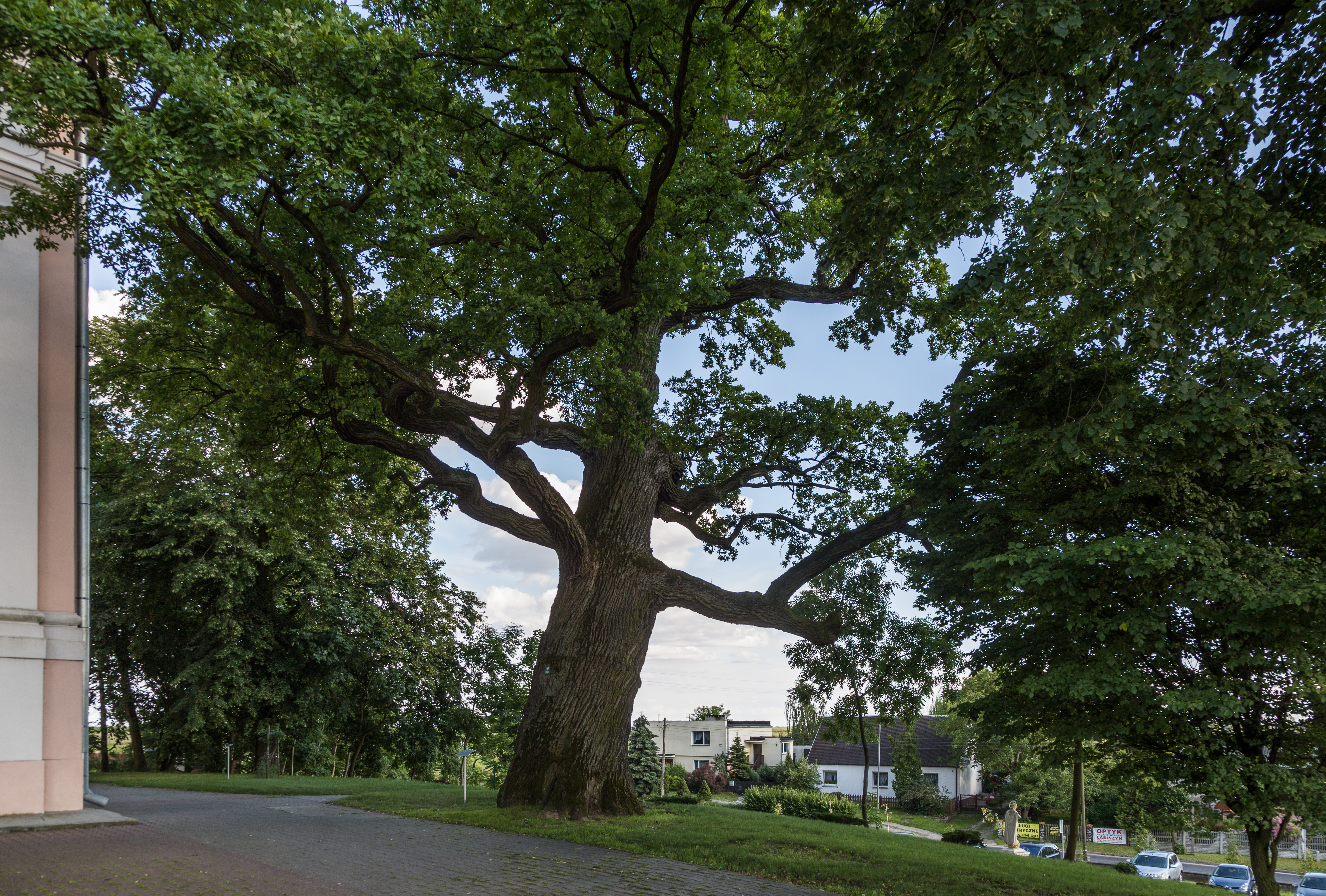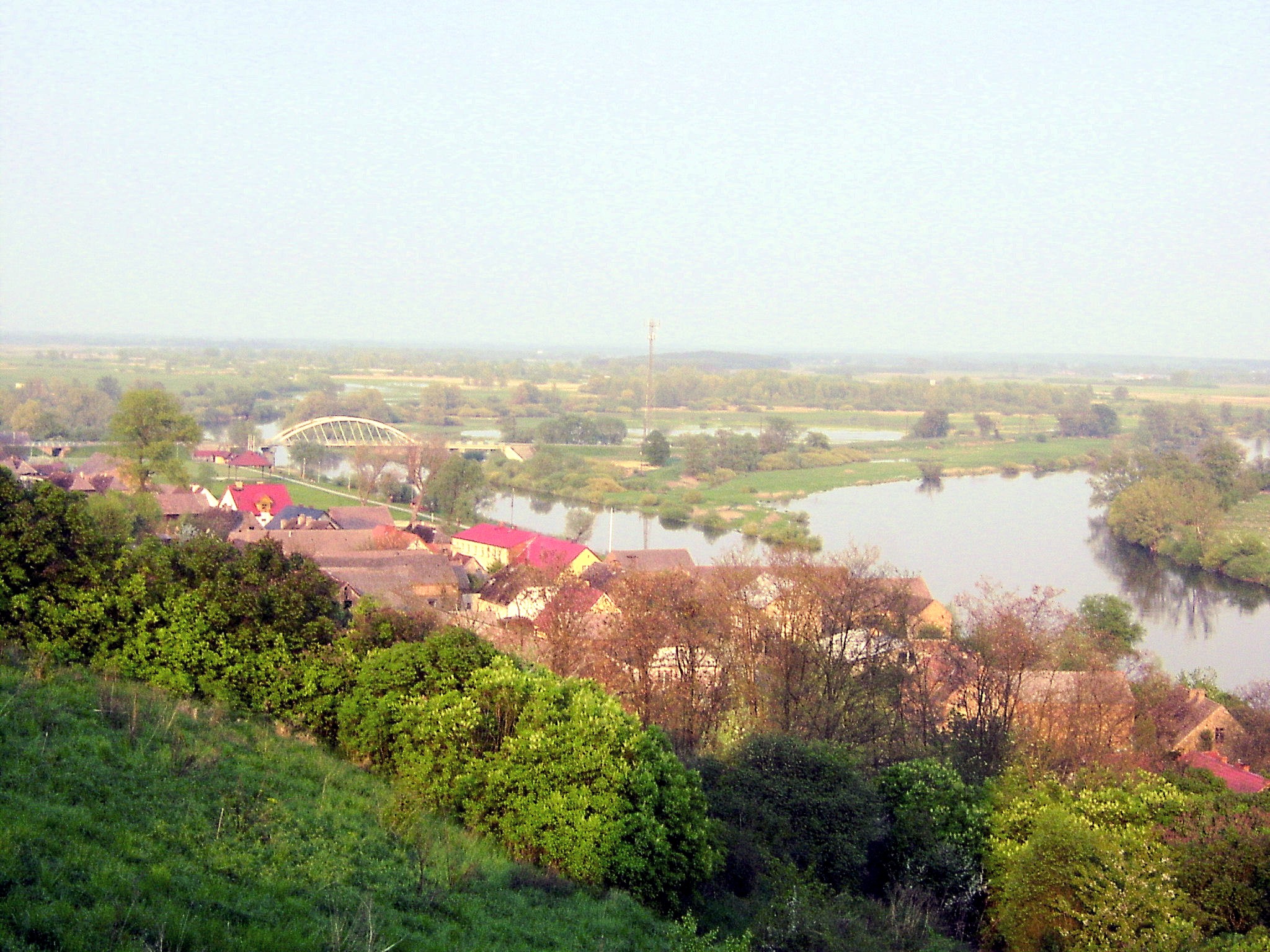|
ŇĀabiszyn
ŇĀabiszyn (german: Labischin, 1940-45: L√ľderitz) is a small town in ŇĽnin County, in the Kuyavian-Pomeranian Voivodeship in Poland, with 4,403 inhabitants (2004). It is located on the Noteńá river near ŇĽnin, on the border between the historic regions of PaŇāuki and Kuyavia. History The first written mention of ŇĀabiszyn comes from the 13th century as an estate owned by a knight, located within medieval Piast-ruled Poland. A document from 1247 mentions Dezydery of ŇĀabiszyn, probably the owner of the settlement. In 1362 the village is mentioned as ''Labissino'' and ''Lambissiono.'' In the 14th century, ŇĀabiszyn belonged to the Prawdzic family. Thanks to their efforts, the settlement and the castle were granted town rights in 1369. In 1407, the town already had its own wax seal with the coat of arms depicting the right, open and severed hand with the inscription "ŇĀabiszyn". King WŇāadysŇāaw JagieŇāŇāo passed through ŇĀabiszyn on November 2, 1410 , on his way from InowrocŇāaw ... [...More Info...] [...Related Items...] OR: [Wikipedia] [Google] [Baidu] |
Gmina ŇĀabiszyn
__NOTOC__ Gmina ŇĀabiszyn is an urban-rural gmina (administrative district) in ŇĽnin County, Kuyavian-Pomeranian Voivodeship, in north-central Poland. Its seat is the town of ŇĀabiszyn, which lies approximately north-east of ŇĽnin and south of Bydgoszcz. The gmina covers an area of , and as of 2006 its total population is 9,435 (out of which the population of ŇĀabiszyn amounts to 4,473, and the population of the rural part of the gmina is 4,962). Villages Apart from the town of ŇĀabiszyn, Gmina ŇĀabiszyn contains the villages and settlements of Annowo, Antoniewo, Buszkowo, JabŇā√≥wko, JabŇāowo PaŇāuckie, JeŇľewice, JeŇľewo, KńÖpie, Klotyldowo, ŇĀabiszyn-WieŇõ, LubostroŇĄ, Nowe DńÖbie, Obielewo, Ob√≥rznia, Ojrzanowo, Opor√≥wek, Oporowo, Ostatkowo, Pszcz√≥Ňāczyn, Rzywno, Smerzyn, Smogorzewo, Wielki Sosnowiec, WŇāadysŇāawowo, Wyrńôba, ZaŇāachowo and Zdziersk. Neighbouring gminas Gmina ŇĀabiszyn is bordered by the gminas of Barcin, BiaŇāe BŇāota, Nowa Wi ... [...More Info...] [...Related Items...] OR: [Wikipedia] [Google] [Baidu] |
ŇĽnin County
__NOTOC__ ŇĽnin County ( pl, powiat ŇľniŇĄski) is a unit of territorial administration and local government (powiat) in Kuyavian-Pomeranian Voivodeship, north-central Poland. It came into being on January 1, 1999, as a result of the Polish local government reforms passed in 1998. Its administrative seat and largest town is ŇĽnin, which lies south-west of Bydgoszcz and west of ToruŇĄ. The county contains three other towns: Barcin, lying east of ŇĽnin, ŇĀabiszyn, lying north-east of ŇĽnin, and Janowiec Wielkopolski, south-west of ŇĽnin. The county covers an area of . As of 2019 its total population is 68,113, out of which the population of ŇĽnin is 13,864, that of Barcin is 7,408, that of ŇĀabiszyn is 4,472, that of Janowiec Wielkopolski is 3,953, and the rural population is 38,416. Neighbouring counties ŇĽnin County is bordered by NakŇāo County to the north, Bydgoszcz County to the north-east, InowrocŇāaw County to the east, Mogilno County to the south-east, Gniezno County t ... [...More Info...] [...Related Items...] OR: [Wikipedia] [Google] [Baidu] |
Kuyavian-Pomeranian Voivodeship
Kuyavian-Pomeranian Voivodeship, also known as Cuiavian-Pomeranian Voivodeship or simply Kujawsko-Pomorskie, or Kujawy-Pomerania Province ( pl, wojew√≥dztwo kujawsko-pomorskie ) is one of the 16 voivodeships (provinces) into which Poland is divided. It was created on 1 January 1999 and is situated in mid-northern Poland, on the boundary between the two historic regions from which it takes its name: Kuyavia ( pl, Kujawy) and Pomerania ( pl, Pomorze). Its two chief cities, serving as the province's joint capitals, are Bydgoszcz and ToruŇĄ. History The Kuyavian-Pomeranian Voivodeship was created on 1 January 1999, as a result of the Polish local government reforms adopted in 1998. It consisted of territory from the former Bydgoszcz, ToruŇĄ and WŇāocŇāawek Voivodeships. The area now known as Kuyavia-Pomerania was previously divided between the region of Kuyavia and the Polish fiefdom of Royal Prussia. Of the two principal cities of today's Kuyavian-Pomeranian voivodeship, one ( Byd ... [...More Info...] [...Related Items...] OR: [Wikipedia] [Google] [Baidu] |
Noteńá
Noteńá (; , ) is a river in central Poland with a length of (7th longest) and a basin area of . , p. 85-86 It is the largest tributary of the river and lies completely within Poland. Course [...More Info...] [...Related Items...] OR: [Wikipedia] [Google] [Baidu] |
Private Town
A private town is a town owned by a private person or a family. History of Private Towns in Poland In the history of Poland, private towns (''miasta prywatne'') were towns within the lands owned by magnates, bishops, knights, princes, etc. Amongst the most well-known former private magnate towns are BiaŇāystok, ZamoŇõńá, Rzesz√≥w, PuŇāawy, Tarn√≥w, Siedlce, BiaŇāa Podlaska, Ivano-Frankivsk (Polish: ''StanisŇāaw√≥w''), Ternopil (Polish: ''Tarnopol'') and Uman (Polish: ''HumaŇĄ''). Magnate palaces and castles can be often found in former private magnate towns. Examples include the Branicki Palace in BiaŇāystok, the Czartoryski Palace in PuŇāawy, the Zamoyski Palace in ZamoŇõńá, the Lubomirski Castle in Rzesz√≥w, the RadziwiŇāŇā Palace in BiaŇāa Podlaska, the OgiŇĄski Palace in Siedlce, the Potocki Palaces in Mińôdzyrzec Podlaski, Tulchyn and Vysokaye, the WiŇõniowiecki Palace in Vyshnivets, the Zbaraski Castle in Zbarazh. The most known former private bishop towns include ŇĀ ... [...More Info...] [...Related Items...] OR: [Wikipedia] [Google] [Baidu] |
Kalisz Voivodeship (1314‚Äď1793)
Kalisz Voivodeship 1314‚Äď1793 (Polish: ''Wojew√≥dztwo Kaliskie'', Latin: ''Palatinatus Calisiensis'') was an administrative unit of Poland from 1314 to the Second Partition of Poland in 1793. It was part of the Greater Polish ''Province''. Its capital was in Kalisz, and together with neighboring PoznaŇĄ Voivodeship, Kalisz elected general starosta of Greater Poland. The sejmiks for the two voivodeships took place at Ňöroda Wielkopolska, while general sejmik for the whole Province of Greater Poland took place in KoŇāo, at the Bernardine Abbey. The territory of the voivodeship remained unchanged from 1314 until 1768, when Gniezno Voivodeship was carved out of its northern three counties. Its original area was 15,320 km2., but after 1768 it shrank to 7,810 km2. Local starostas resided at Kalisz, Gniezno, Konin, Kcynia, Naklo, Pyzdry, and ZŇāot√≥w. Kalisz Voivodeship had eight senators. These were: Archbishop of Gniezno, Voivode of Kalisz (who resided at the Kalisz Royal ... [...More Info...] [...Related Items...] OR: [Wikipedia] [Google] [Baidu] |
Greater Poland Province Of The Polish Crown
, subdivision = Province , nation = Poland , year_start = , event_end = Third Partition of Poland , year_end = , image_map = Prowincje I RP.svg , image_map_caption = , capital = PoznaŇĄ , political_subdiv = 13 voivodeships and one duchy , common_name = Greater Poland Province ( pl, Prowincja Wielkopolska) was an administrative division of the Crown of the Kingdom of Poland from 1569 until 1795. The name of the province comes from the historic land of Greater Poland. The Greater Poland Province consisted initially of twelve voivodeships (after 1768 thirteen voivodeships)Lucjan Tatomir, ''Geografia og√≥lna i statystyka ziem dawnej Polski'', Drukarnia "Czasu" W. Kirchmayera, Krak√≥w, 1868, p. 147 (in Polish) and one duchy: # BrzeŇõńá Kujawski Voivodeship # CheŇāmno Voivodeship # Gniezno Voivodeship, est. in 1768 # InowrocŇāaw Voivodeship # Kalisz Voivodeshi ... [...More Info...] [...Related Items...] OR: [Wikipedia] [Google] [Baidu] |
Polish Academy Of Sciences
The Polish Academy of Sciences ( pl, Polska Akademia Nauk, PAN) is a Polish state-sponsored institution of higher learning. Headquartered in Warsaw, it is responsible for spearheading the development of science across the country by a society of distinguished scholars and a network of research institutes. It was established in 1951, during the early period of the Polish People's Republic following World War II. History The Polish Academy of Sciences is a Polish state-sponsored institution of higher learning, headquartered in Warsaw, that was established by the merger of earlier science societies, including the Polish Academy of Learning (''Polska Akademia UmiejńôtnoŇõci'', abbreviated ''PAU''), with its seat in Krak√≥w, and the Warsaw Society of Friends of Learning (Science), which had been founded in the late 18th century. The Polish Academy of Sciences functions as a learned society acting through an elected assembly of leading scholars and research institutions. The Academy h ... [...More Info...] [...Related Items...] OR: [Wikipedia] [Google] [Baidu] |
Kalisz
(The oldest city of Poland) , image_skyline = , image_caption = ''Top:'' Town Hall, Former "Calisia" Piano Factory''Middle:'' Courthouse, "GoŇāńôbnik" tenement''Bottom:'' Aerial view of the Kalisz Old Town , image_flag = POL Kalisz flag.svg , flag_border = no , image_shield = POL Kalisz COA.svg , pushpin_map = Poland Greater Poland Voivodeship#Poland , pushpin_relief = 1 , pushpin_label_position = bottom , subdivision_type = List of sovereign states, Country , subdivision_name = , subdivision_type1 = Voivodeships of Poland, Voivodeship , subdivision_name1 = , subdivision_type2 = Powiat, County , subdivision_name2 = ''city-county'' , leader_title = Mayor , leader_name = Krystian Kinastowski , established_title = Established , established_date = 9th century , established_title3 = Town rights , established_date3 = after 1268 , area_total_km2 = 69.42 , population_as_of = 31 December 2021 , population_total = 97,905 (List of cities and towns in Poland, 38th) ... [...More Info...] [...Related Items...] OR: [Wikipedia] [Google] [Baidu] |
Voivodeships Of Poland
A voivodeship (; pl, województwo ; plural: ) is the highest-level administrative division of Poland, corresponding to a province in many other countries. The term has been in use since the 14th century and is commonly translated into English as "province". The Polish local government reforms adopted in 1998, which went into effect on 1 January 1999, created sixteen new voivodeships. These replaced the 49 former voivodeships that had existed from 1 July 1975, and bear a greater resemblance (in territory, but not in name) to the voivodeships that existed between 1950 and 1975. Today's voivodeships are mostly named after historical and geographical regions, while those prior to 1998 generally took their names from the cities on which they were centered. The new units range in area from under (Opole Voivodeship) to over (Masovian Voivodeship), and in population from nearly one million (Opole Voivodeship) to over five million (Masovian Voivodeship). Administrative authority at th ... [...More Info...] [...Related Items...] OR: [Wikipedia] [Google] [Baidu] |
OpaliŇĄski Family
OpaliŇĄski (plural OpaliŇĄscy) was the name of an old and notable Polish noble family which produced one Queen Consort of Poland. History They originated from the town of Opalenica and used the Coat of arms of ŇĀodzia. They were powerful players in the politics of Poland in the 16th and 17th centuries. One branch of the family hailed from Sierak√≥w. Notable members Its notable members included: * Jan OpaliŇĄski (1546‚Äď1598), father of ** Jan OpaliŇĄski (1581‚Äď1637) ** Piotr OpaliŇĄski (1586‚Äď1624), father of *** Krzysztof OpaliŇĄski (1611‚Äď1655), father of **** Jan Karol OpaliŇĄski (1642‚Äď1695), father of ***** Katarzyna OpaliŇĄski (1680‚Äď1747), Queen consort of Poland *** ŇĀukasz OpaliŇĄski (1612‚Äď1666) * ŇĀukasz OpaliŇĄski (1581‚Äď1654) Coat of arms image:POL COA ŇĀodzia.svg, The OpaliŇĄski family used the ŇĀodzia coat of arms. Palaces File:Palace in BiaŇāńôŇľyce.JPG, Ruined OpaliŇĄski Palace in BiaŇāńôŇľyce image:Spytkowice.jpg, Castle in Spytko ... [...More Info...] [...Related Items...] OR: [Wikipedia] [Google] [Baidu] |
Battle Of Koronowo
The Battle of Koronowo was a battle of the Polish‚ÄďLithuanian‚ÄďTeutonic War. It took place on 10 October 1410, near the village of ŇĀńÖsko Wielkie and ended in victory for the Polish‚Äď Lithuanian alliance. This is the account of the battle of Jan DŇāugosz, from the abridged translation by Maurice Michael, pp. 399‚Äď401: The Order's troops hasten back to their horses and start to withdraw. Their idea is that, if the Poles, who are on foot, get far enough from the town, the rest of the garrison will be unable to come to their assistance should fighting start. However, the Polish archers fire flight after flight of arrows at the withdrawing Knights which wound many of them and allow the Poles to get in among them and kill many more. Every time the enemy turns to attack the archers, these withdraw in among their own knights, where they are safe, and from where they emerge later and start shooting again. This skirmish continues for over a mile, until the enemy reaches a vi ... [...More Info...] [...Related Items...] OR: [Wikipedia] [Google] [Baidu] |







.jpg)